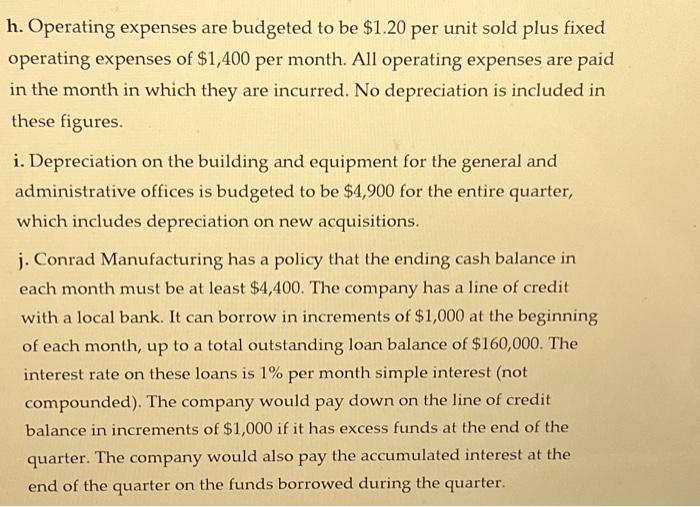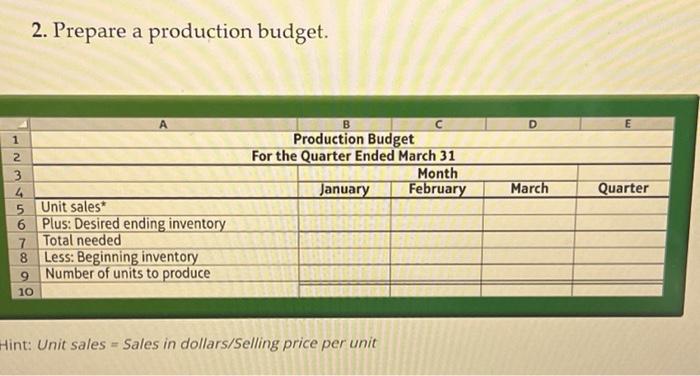P9-71B. Comprehensive budgeting problem (Learning Objectives 2 \& 3 ) Conrad Manufacturing is preparing its master budget for the first quarter of the upcoming year. The following data pertain to Conrad Manufacturing's operations: a. Actual sales in December were $76,000. Selling price per unit is projected to remain stable at $9 per unit throughout the budget period. Sales for the first five months of the upcoming year are budgeted to be as follows: b. Sales are 30% cash and 70% credit. All credit sales are collected in the month following the sale. c. Conrad Manufacturing has a policy stating that each month's ending inventory of finished goods should be 10% of the following month's sales (in units). d. Of each month's direct materials purchases, 20% are paid for in the month of purchase, while the remainder is paid for in the month following purchase. Two pounds of direct material is needed per unit at $1.50 per pound. Ending inventory of direct materials should be 20% of next month's production needs. e. Most of the labor at the manufacturing facility is indirect, but there is some direct labor incurred. The direct labor hours per unit is 0.03 . The direct labor rate per hour is $13 per hour. All direct labor is paid for in the month in which the work is performed. The direct labor total cost for each of the upcoming three months is as follows: f. Monthly manufacturing overhead costs are $6,500 for factory rent, $2,900 for other fixed manufacturing expenses, and $1.40 per unit for variable manufacturing overhead. No depreciation is included in these figures. All expenses are paid in the month in which they are incurred. g. Computer equipment for the administrative offices will be purchased in the upcoming quarter. In January, the company will purchase equipment for $5,800 (cash), while February's cash expenditure will be $11,600 and March's cash expenditure will be $15,800. h. Operating expenses are budgeted to be $1.20 per unit sold plus fixed operating expenses of $1,400 per month. All operating expenses are paid in the month in which they are incurred. No depreciation is included in these figures. i. Depreciation on the building and equipment for the general and administrative offices is budgeted to be $4,900 for the entire quarter, which includes depreciation on new acquisitions. j. Conrad Manufacturing has a policy that the ending cash balance in each month must be at least $4,400. The company has a line of credit with a local bank. It can borrow in increments of $1,000 at the beginning of each month, up to a total outstanding loan balance of $160,000. The interest rate on these loans is 1% per month simple interest (not compounded). The company would pay down on the line of credit balance in increments of $1,000 if it has excess funds at the end of the quarter. The company would also pay the accumulated interest at the end of the quarter on the funds borrowed during the quarter. k. The company's income tax rate is projected to be 30% of operating income less interest expense. The company pays $10,800 cash at the end of February in estimated taxes. Requirements 1. Prepare a schedule of cash collections for January, February, and March, and for the quarter in total. 2. Prepare a production budget. Hint: Unit sales = Sales in dollars/Selling price per unit 3. Prepare a direct materials budget. 4. Prepare a cash payments budget for the direct material purchases from Requirement 3, using the following format. (Use the accounts payable balance at December 31 of prior year for the prior month payment in January.) 5. Prepare a cash payments budget for direct labor, using the following format: 6. Prepare a cash payments budget for manufacturing overhead costs. 7. Prepare a cash payments budget for operating expenses. 8. Prepare a combined cash budget. 9. Calculate the budgeted manufacturing cost per unit (assume that fixed manufacturing overhead is budgeted to be $0.70 per unit for the year). 10. Prepare a budgeted income statement for the quarter ending March 31. 1. Total Cash Collected $247,240 2. Units produced 28,060 3. Total cost of DM$84,426 4. Total DM payments $105,188 5. Total DL cost $10,944 6. Total MOH Payments $67,484 7. Total OpEx Payments $37,800 8. Ending Cash balance $4,674 9. CoGM per unit $5.49 10. Net income $38.479 P9-71B. Comprehensive budgeting problem (Learning Objectives 2 \& 3 ) Conrad Manufacturing is preparing its master budget for the first quarter of the upcoming year. The following data pertain to Conrad Manufacturing's operations: a. Actual sales in December were $76,000. Selling price per unit is projected to remain stable at $9 per unit throughout the budget period. Sales for the first five months of the upcoming year are budgeted to be as follows: b. Sales are 30% cash and 70% credit. All credit sales are collected in the month following the sale. c. Conrad Manufacturing has a policy stating that each month's ending inventory of finished goods should be 10% of the following month's sales (in units). d. Of each month's direct materials purchases, 20% are paid for in the month of purchase, while the remainder is paid for in the month following purchase. Two pounds of direct material is needed per unit at $1.50 per pound. Ending inventory of direct materials should be 20% of next month's production needs. e. Most of the labor at the manufacturing facility is indirect, but there is some direct labor incurred. The direct labor hours per unit is 0.03 . The direct labor rate per hour is $13 per hour. All direct labor is paid for in the month in which the work is performed. The direct labor total cost for each of the upcoming three months is as follows: f. Monthly manufacturing overhead costs are $6,500 for factory rent, $2,900 for other fixed manufacturing expenses, and $1.40 per unit for variable manufacturing overhead. No depreciation is included in these figures. All expenses are paid in the month in which they are incurred. g. Computer equipment for the administrative offices will be purchased in the upcoming quarter. In January, the company will purchase equipment for $5,800 (cash), while February's cash expenditure will be $11,600 and March's cash expenditure will be $15,800. h. Operating expenses are budgeted to be $1.20 per unit sold plus fixed operating expenses of $1,400 per month. All operating expenses are paid in the month in which they are incurred. No depreciation is included in these figures. i. Depreciation on the building and equipment for the general and administrative offices is budgeted to be $4,900 for the entire quarter, which includes depreciation on new acquisitions. j. Conrad Manufacturing has a policy that the ending cash balance in each month must be at least $4,400. The company has a line of credit with a local bank. It can borrow in increments of $1,000 at the beginning of each month, up to a total outstanding loan balance of $160,000. The interest rate on these loans is 1% per month simple interest (not compounded). The company would pay down on the line of credit balance in increments of $1,000 if it has excess funds at the end of the quarter. The company would also pay the accumulated interest at the end of the quarter on the funds borrowed during the quarter. k. The company's income tax rate is projected to be 30% of operating income less interest expense. The company pays $10,800 cash at the end of February in estimated taxes. Requirements 1. Prepare a schedule of cash collections for January, February, and March, and for the quarter in total. 2. Prepare a production budget. Hint: Unit sales = Sales in dollars/Selling price per unit 3. Prepare a direct materials budget. 4. Prepare a cash payments budget for the direct material purchases from Requirement 3, using the following format. (Use the accounts payable balance at December 31 of prior year for the prior month payment in January.) 5. Prepare a cash payments budget for direct labor, using the following format: 6. Prepare a cash payments budget for manufacturing overhead costs. 7. Prepare a cash payments budget for operating expenses. 8. Prepare a combined cash budget. 9. Calculate the budgeted manufacturing cost per unit (assume that fixed manufacturing overhead is budgeted to be $0.70 per unit for the year). 10. Prepare a budgeted income statement for the quarter ending March 31. 1. Total Cash Collected $247,240 2. Units produced 28,060 3. Total cost of DM$84,426 4. Total DM payments $105,188 5. Total DL cost $10,944 6. Total MOH Payments $67,484 7. Total OpEx Payments $37,800 8. Ending Cash balance $4,674 9. CoGM per unit $5.49 10. Net income $38.479




















